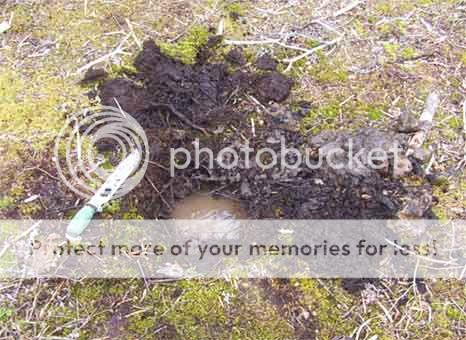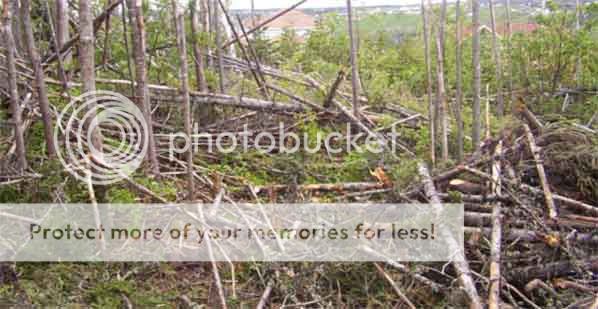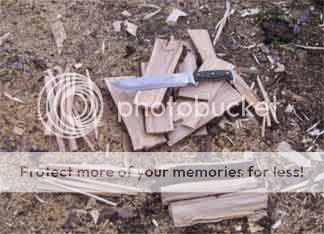Here is an old post by Cliff on the knife.
[QUOTE="Cliff Stamp I have a lot of wood working to do, clear a few lots, cut wood for the winter etc., and generally it isn't overly exciting so I usually take some knives and break up the tedium by doing other things. I was mainly interested if the edge on the knife could take harder limbing as I had adjusted it to a fairly thin 8/12 profile :
I did a lot of sloppy work like that and did finally manage to turn the edge just to the point where I was almost positive it was bent. I later confirmed it when I sharpened it as you can see where it is abraded, but it took an extended sesstion of sloppy limbing on really hard work to turn the edge and even then it was very slight. That is the best performance I have seen to date, and this is a large blade and it hits really hard.
I also did a bunch of finer work, including some really thin splitting :
Some of these spints are actually as thin as the individual rings of the wood. I was reminded then of the weak points of the grip as the choil could really benefit from extensive rounding. That is just green guard tape on the handle, I was experimenting with really thick grips when I put it on and I put rubber tape under the green tape as an underlay to absorb shock, it works well and the grip feels much like the rubber Swamp Rat grips.
With the splits and all those limbs and boughs it was no trouble getting a fire going, I started it on a pit used last years to burn some boughs :
I also did some digging to check the water levels as the ground here is fairly peaty :
You can't dig it very easily with a stick, there are way too many roots. It is much easier to use a knife to cut all the roots out of the way and pry up the rocks. Nothing serious to the knife, the edge was a little impacted in the tip from working it under the rocks. The water came in very rapid. I took out a gallon and just minutes later it was that level again.
For those not familiar with the design, that is an older straight handled Battle Mistress, the current evolution of the design is the Fusion model which has a similar blade but radically different grip.
-Cliff
_____________________
[QUOTE="Cliff Stamp, The edge bevels are really dramatic, the edge is 0.070" thick and 0.25" wide, yeah that isn't a typo, it is eight degrees per side. It was actually this angle origionally for the entire bevel but I found the edge would turn on harder knots in the winter when I was cutting frozen wood and thus the edge retention was low so I increased it to 12 by adding a secondary bevel which sets in at about 0.040" or so. You can't see a distinction in the bevels by eye, I just freehand sharpen it on flat stones and it all blends together.
The origional profile was about 35 degrees included and I kept grinding it down trying to see when it would start to get damaged. It was very difficult to reduce it to eight per side, I was working in the slack above the platen on a belt sander and this angle is so low that you end up grinding the spine as well so there is a big strip of metal removed from the knife there as well. It is much easier to grind on the platen, but back when I modifed it I found it easier to work on the slack section of the belt.
The ground isn't soft to walk on, you won't sink in it for example, however most of it is moss covered which means hauling the wood out can be problematic because there is little traction. You also have to be fairly careful when carrying wood due to the footing, I broke one of the bones in my feet awhile back when I stepped on a sharp rock which shifted which I didn't see as it was covered in that thick moss. The biggest problem for cutting wood is that if the roots run through that ground the tree is loosely held in place thus it will move with the axe which not only severely limits penetration it makes it fairly dangerous, especially if the wood is hard.
I am helping a friend clear a lot to build and also clearing family owned land for wood to burn which will eventually be developed for building lots. However it will likely be grown back in by the time that happens as there is a lot of wood owned by our familiy locally and there are lots that were cleared a long time ago which are now heavily grown back in again.
-Cliff
________
[QUOTE="Cliff Stamp, Length of the blade vs width of the bit, so 10" vs 3". The best way I have found is to just do just straight push cuts with the axe because you can't sweep much through a few inches. In terms of time it is still well behind the blade and even more in regards to the fatigue rate. They are not in the same class, it is a many to one difference in terms of overall functinality.
Doing some more work with the Battle Mistress, I had intended to spend some time burning debris but it stopped raining so I spent some time clean up instead, just getting rid of brush, small wood and debris to make axe work easier. A before shot :
A long blade is much more efficient here than a axe, saw or small blade, and even than all of them combined. It easily cuts away the brush deftly, chops through the larger sticks as necessary in a few seconds and prys up the roots when necessary or hacks through them. Some of this is old fencing as well so it readily works as a prybar popping the sections off of the nails. It only takes about 15 minutes to turn the above into :
I spent about an hour doing that on one side of the lot before doing some more chopping and limbing comparisons. The knife made it ease to haul out massive amounts of material with the combined ability to cut small brush, chop heavy wood and hammer/pry as necessary :
I have made a bunch of lean-tos and debris shelters as well as other things like elevated platform beds, there are pictures of them in the reviews. In general there is no reason to work with larger wood and it is far less efficient both in cutting it down, moving it plus preparing it. A regular debris shelter is actually fairly robust, I have seen them several years later being still perfectly fine. The only general concern is the vegetation tends to dry and rot so it needs to be replaced. But even without cordage to keep the frame together, it has no problem handing the elements.
-Cliff

















